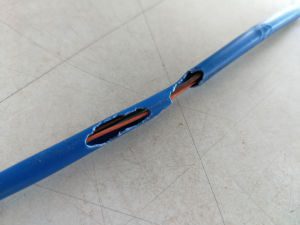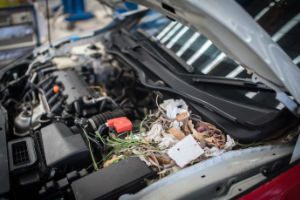YOUR CAR MAY FALL VICTIM TO MICE THIS WINTER
By Zachary Ciras on February 18, 2020.
There’s a group of wintertime pests that can cause significant damage requiring costly repairs in just a short time. They are active even if it’s cold and snowy. They are rarely seen and the damage may not be discovered until it’s too late and someone has been seriously injured or even killed. It’s up to you to stop them!

Insulation around wiring chewed by rodents. Shutterstock.
What are we talking about? The growing problem of rodents (mice, rats, squirrels) chewing on vehicle parts, especially wiring. In the past, vehicle owners with such rodent-caused damage have faced great difficulty getting their auto insurance to cover the cost, which can be several hundred dollars (see Rodent Damage to Vehicles).
WHY DO RODENTS DO IT?
We know that rats, mice, and squirrels love to gnaw on things but what’s so attractive about vehicle wiring? There has been speculation that rodent damage increased several years ago when auto manufacturers began using biodegradable, soy-based wiring insulation in an attempt to go “green.” Soy is food-based and may be enough to attract a hungry mouse. A further attraction in winter may be road salt residue on various inner parts. Many animals are drawn to “salt licks.”
All of the action isn’t under the hood, however. Word is that manufacturers are also incorporating soy into vehicle seats and other interior parts. Even without that added attraction, the inside of a car with seat stuffing, etc. provides a perfectly nice nest site. What’s not to like?
VEHICLE DAMAGE IS NOT THE ONLY ISSUE
While rodent nesting and damage to vehicles can occur at any time, winter does seem to be prime time. In winter, a vehicle provides good shelter from the elements, protection from predators, maybe heat from the engine, and sometimes even food crumbs left by the last occupant. Rodents may just be passing through when they stop to chew on vehicle parts but they often are nesting in the vehicle as well.

Rodent nest beneath the hood of a car with newborn mice living inside. Shutterstock.
Besides the physical damage to your vehicle, nesting rodents leave behind parasites (fleas, mites, ticks) and droppings which can transmit diseases to people. You really don’t want to be driving to work, inhaling through your car’s ventilation system airborne disease organisms from the mouse nest under the hood. Using various repellents under the hood to keep rodents from nesting or chewing is not a good idea for the same reason.
WHAT CAN YOU DO TO PREVENT RODENT-CAUSED VEHICLE DAMAGE?
The most obvious answer to this question is to garage your vehicle, although even that is no guarantee. Rodents easily enter around most garage doors. Rodent-proofing the garage door is a good start (see Maintain Your Garage Door to Keep Mice Out). Still, junker vehicles, those rarely driven, and those parked outside are most likely to be victims.
1. Clean out your vehicle. Clutter, and especially fast food wrappers, provides food, protection, and nest material for mice and other rodents.
2. Check under the hood regularly for gnawed wires or parts and nest material. Use your nose: urine, droppings, and nest debris won’t do your engine any good either.
3. If your vehicle is garaged, make sure the garage itself is not attracting mice. Move or secure pet food, bird seed, kitty litter boxes, and garbage cans.
4. If you have to clean rodent nests out of a heavily-infested vehicle, be careful not to stir up droppings and nest material that you might then inhale.
If you do find yourself the victim of rodent vehicle damage, it might be a good idea to first take a picture of any nest material or rodent traces, for insurance purposes. And give Colonial Pest a call. We can’t fix your car but we can usually fix your rodent problem!